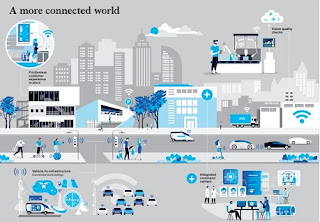5G Connected World
An evolution in
connectivity beyond
the 5G revolution:
The promise of 5G has captured the attention of business leaders, policy makers, and the
media. But how much of that promise is likely to be realized anytime soon?
With the first true high-band 5G networks already live, we set out to take a realistic view of how and where connectivity could be deployed and what it can enable over the next 10 years. But 5G is not appearing in isolation. This research takes a more expansive view of connectivity to include other technologies, ranging from fiber and satellites to Wi-Fi and short-range technologies.
Despite the hype about remote surgery and Star Trek–style holodecks in everyone’s living rooms, the future is not solely happening on the frontier. Existing connectivity technologies are expanding and evolving, with new standards that boost network performance—and they are much less capital-intensive. We have identified an enormous array of use cases that can run on this type of upgraded backbone. Companies do not have to wait for high-band 5G to implement new systems and go after the resulting productivity gains. To illustrate what is possible, this research looks at how connectivity could be deployed in mobility, healthcare, manufacturing, and retail. The use cases we identified in these four commercial domains alone could boost global GDP by $1.2 trillion to $2 trillion by 2030. This implies that the value at stake will ultimately run trillions of dollars higher across the entire global economy. Most of this value can be captured with advanced connectivity, using technologies that have been available for some time now.
This raises a puzzling question: Why is so much potential still sitting on the table, and will new technologies alone be enough to realize it? This research looks at the issues holding back the market, with the aim of starting a broader conversation about what it will take to create momentum. It is part of an ongoing body of work that will continue exploring connectivity, including its possibilities in other sectors and its impact across broader economies.
Use cases that require frontier connectivity such as high-band 5G could eventually generate some 20 to 30 percent of the potential impact, based on the use cases we have sized. High-band 5G will create greater network efficiency, boosting speeds and lowering latency even as providers accommodate more consumer-driven traffic and more devices. Existing use cases can run on a bigger scale while becoming more sophisticated and reliable. For example, these capabilities could open the doors to deploying tens of thousands of infrastructure sensors in a dense urban area, streaming data to consumer vehicles and public institutions securely in real time to enable safety features and faster emergency response.11 It is possible that the value of use cases running on frontier connectivity could exceed our estimates, depending on whether some high-potential but still speculative use cases like augmented reality and self-driving vehicles reach mass adoption by decade’s end.
A stronger digital backbone can also support new applications we cannot predict today. The extent to which these developments—and the related demand—actually materialize will likely have a meaningful impact on the deployment and adoption of frontier connectivity. In addition to the potential in these four commercial domains, advances in technology, coverage, and affordability can bring more of the world online. Aging or inadequate networks will be upgraded in future investment cycles, while new digital networks will reach some regions for the first time. Today 40 percent of the global addressable adult population is still under-connected (in other words, not yet using 3G-capable data networks or better) or altogether offline due to inadequate coverage, affordability barriers, or insufficient relevance (such as content in the local language). By 2030, that share could be cut in half. This will be enabled by a combination of trends, including not only wider network coverage but also the growing affordability of devices and data plans, the development of more relevant internet content, and demographic and social shifts (like increasing urbanization rates).
This newly
online population will benefit from intermediate connectivity via 3G or 4G/LTE cellular
networks for basic web browsing, consumer mobile phone applications, e-commerce, and
online video.12 Global GDP could increase by another $1.5 trillion to $2 trillion as a billion
people gain better access to digital information, tools, and services.
Copyright © McKinsey & Company
5G Challenges, Identifies Opportunities for Development
Fifth-generation (5G) wireless technology can enable new capabilities with increased speeds and device connection, the Government Accountability Office said in a new report, but also presents challenges and policy options to the Federal government.
Among the challenges that can hold back the U.S. from utilizing 5G technologies, GAO identified the following:- Spectrum availability and efficiency;
- Cybersecurity;
- Privacy; and
- Concern over possible health effects.
To address the potential challenges as they relate to 5G, GAO offered several policy options for policymakers:“To reach the full potential of 5G, new technologies will need to be developed,” wrote GAO. “International bodies that have been involved in defining 5G network specifications will need to develop additional 5G specifications and companies will need to develop, test, and deploy these technologies.”
- Support R&D for spectrum sharing technologies which could allow for more efficient use of limited spectrum available for 5G and future wireless networks;
- Support nationwide, coordinated cybersecurity monitoring of 5G networks which could allow for a knowledgeable understanding of evolving threats, identify cybersecurity risks, and allow stakeholders to act rapidly in response to emerging threats;
- Adopt cybersecurity requirements for 5G networks to decrease time and cost of developing and implementing requirements;
- Adopt uniform practices for 5G user data; and
- Promote R&D for high-band technology which could result in improved statistical modeling of antenna characteristics and improved understanding of any possible health effects from long-term radio frequency exposure to high-band emissions.
“5G network performance improvements are expected to enable new kinds of applications that are to significantly improve mobile broadband experiences, enable communication among a massive number of devices, and introduce faster and more reliable communications between devices, among other things,” wrote GAO. “Together, these improvements will help to enable applications such as 3D video, augmented or virtual reality, smart cities, and automated vehicles.”





Comments
Post a Comment